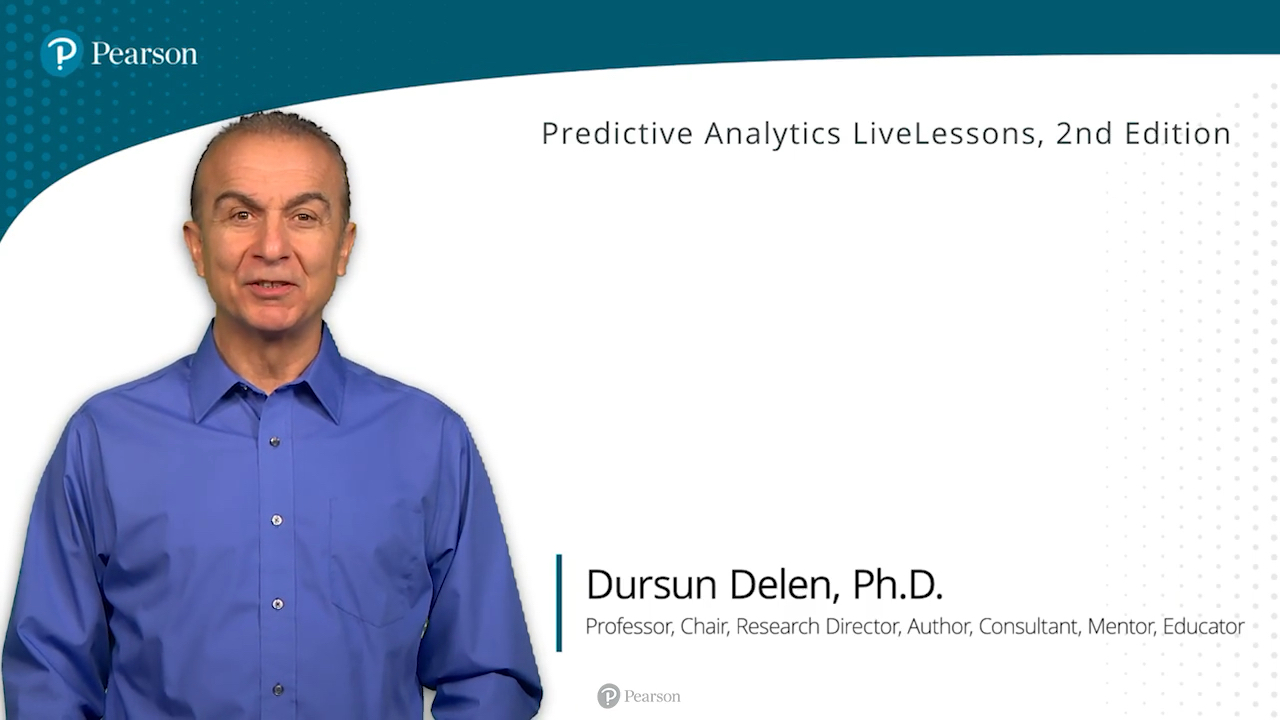Predictive Analytics 2e (LiveLessons), 2nd Edition
- By Dursun Delen
- Published Sep 12, 2022 by Addison-Wesley Professional.
Online Video
- Your Price: $279.99
- List Price: $349.99
- About this video
Video accessible from your Account page after purchase.
Register your product to gain access to bonus material or receive a coupon.
Description
- Copyright 2023
- Edition: 2nd
- Online Video
- ISBN-10: 0-13-790758-3
- ISBN-13: 978-0-13-790758-8
6+ Hours of Video Instruction
This course is designed to bring a holistic, approachable, and best-practice-driven learning experience to predictive analytics.
Overview:
Updated and revamped, Predictive Analytics, 2nd Edition, provides comprehensive (yet easy-to-digest) coverage of business analytics concepts, applications, methods, and tools, with a special emphasis on predictive modeling and analysis. Over the course of the eight lessons, you will learn fundamental concepts, methods, and algorithms of business analytics and data mining, as well as their application areas and best practices. You also learn how to use a variety of software tools (both commercial as well as free/open source) and how to use those tools to discover knowledge from a wide variety of data sources.
At the end of the course, you will not only know what predictive analytics is and what it can do for an organization but also develop basic skills to practice predictive analytics using numerous tools and platforms, most of which are free and open source. The course is designed to provide thorough coverage of the underlying concepts and definitions of predictive analytics in order to demystify the concepts and terminology of these popular evidence-based managerial decisioning trends and then help build hands-on skills with the most popular analytics tools and platforms using intuitive examples and data sets.
Lesson Descriptions:
- Lesson 1: Introduction to Predictive Analytics
- Lesson 2: Introduction to Predictive Analytics and Data Mining
- Lesson 3: The Data Mining Process
- Lesson 4: Data and Methods in Data Mining
- Lesson 5: Data Mining Algorithms
- Lesson 6: Text Analytics and Text Mining
- Lesson 7: Big Data Analytics
- Lesson 8: Predictive Analytics Best Practices
There is not a required minimum skill or knowledge level to take this course. Because of its holistic coverage, the course appeals to anyone (students and professionals) at any level of technical or managerial skill levels who is interested in learning about predictive analytics and its value propositions.
Learn How To:
The course provides thorough yet easy-to-digest coverage of predictive analytics concepts, theories, and best practices, followed by visual, intuitive, and highly practical hands-on illustrative examples using a variety of data sets and industry-leading software tools and platforms.
Who Should Take This Course:
This course is designed for anyone who is interested in learning about the best practices of predictive analytics and anyone who seeks to rapidly move into practical application of this popular technology with a minimal investment of time and resources.
Course Requirements:
There are no specific prerequisites or must-have requirements for this course. It is designed to attract and benefit anyone at any skill and managerial level who is interested in learning predictive analytics.
About Pearson Video Training:
Pearson publishes expert-led video tutorials covering a wide selection of technology topics designed to teach you the skills you need to succeed. These professional and personal technology videos feature world-leading author instructors published by your trusted technology brands: Addison-Wesley, Cisco Press, Pearson IT Certification, Sams, and Que Topics include: IT Certification, Network Security, Cisco Technology, Programming, Web Development, Mobile Development, and more. Learn more about Pearson Video training at http://www.informit.com/video.
Video Lessons are available for download for offline viewing within the streaming format. Look for the green arrow in each lesson.
Sample Content
Table of Contents
Introduction
Lesson 1: Introduction to Predictive Analytics
1.1 What Is Analytics and Where Does Data Mining Fit In?
1.2 Popularity and Application Areas of Analytics
1.3 An Analytics Timeline and a Simple Taxonomy
1.4 Cutting Edge of Analytics: IBM Watson
1.5 Real-World Analytics Applications
Lesson 2: Introduction to Predictive Analytics and Data Mining
2.1 What Is Data Mining, and What Is It Not?
2.2 The Most Common Data Mining Applications and Tools
2.3 Demonstration of Predictive Modeling with Python
2.4 Demonstration of Predictive Modeling with KNIME
Lesson 3: The Data Mining Process
3.1 The Knowledge Discovery in Databases (KDD) Process
3.2 Cross-Industry Standard Process for Data Mining (CRISP-DM)
3.3 Sample, Explore, Modify, Model and Assess (SEMMA) Process and Six Sigma Process
3.4 Demonstration of Data Mining Tools: IBM SPSS Modeler and R
Lesson 4: Data and Methods in Data Mining
4.1 The Nature of Data in Data Mining
4.2 Data Mining Methods: Predictive versus Descriptive
4.3 Evaluations Methods in Data Mining
4.4 Classification with Decision Trees
4.5 Clustering with the k-Means Algorithm
4.6 Association Analysis with Apriori Algorithm
Lesson 5: Data Mining Algorithms
5.1 The Nearest Neighbor Algorithm for Prediction Modeling
5.2 Artificial Neural Networks (ANN) and Support Vector Machines (SVM)
5.3 Linear Regression and Logistic Regression
5.4 Demonstration of Linear Regression and Logistic Regression with Python and KNIME
Lesson 6: Text Analytics and Text Mining
6.1 Introduction to Text Mining and Natural Language Processing
6.2 Text Mining Applications and Text Mining Process
6.3 Text Mining Tools and Demonstration of Text Mining Using Rapid Miner
6.4 Text Mining Tools and Demonstration of Sentiment Analysis and Topic Modeling with KNIME
Lesson 7: Big Data Analytics
7.1 What Is Big Data and Where Does It Come From?
7.2 Fundamental Concepts and Technologies of Big Data
7.3 Who Are Data Scientists and Where Do They Come From?
7.4 Demonstration of Big Data Analytics (SAS Visual Analytics)
Lesson 8: Predictive Analytics Best Practices
8.1 Defining and Model Ensembles and Their Pros and Cons
8.2 Bias-Variance Tradeoff in Predictive Analytics
8.3 Treating Data-Imbalance Problem with Over- and Undersampling
8.4 Explainable ML/AI/Predictive Analytics
8.5 Showcasing Better Practices with a Comprehensive Model of Customer Churn Analysis
Summary
